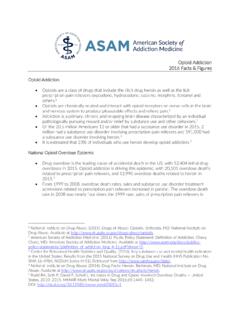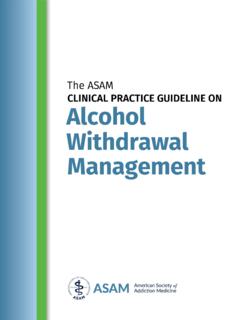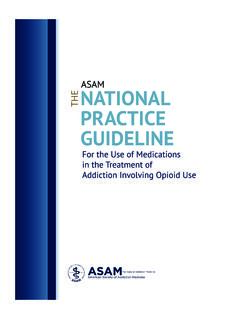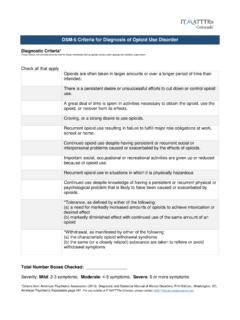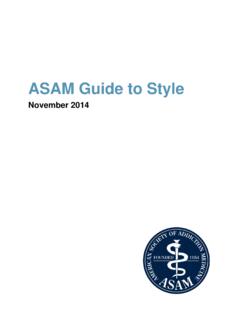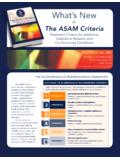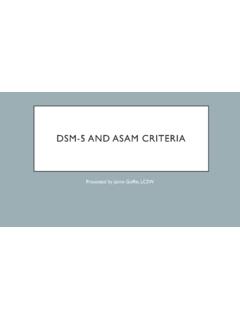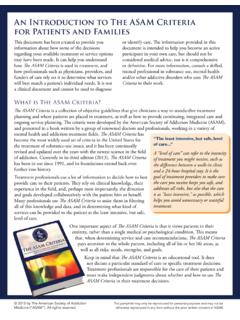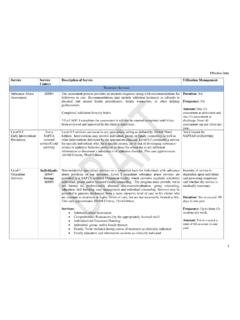Transcription of Treating Opioid Addiction as a Chronic Disease
1 Treating Opioid Addiction as a Chronic Disease The United States is Currently in the Midst of an Opioid Overdose Epidemic According to a 2011 CDC report, use of illegal opioids such as heroin and the non-medical use of certain prescription Opioid pain medications such as oxycodone have risen to epidemic levels with rates that are continuing to soar. Deaths from Opioid overdose have tripled since Further, in 2010, Drug Abuse Warning Network (DAWN) estimated that approximately million emergency department visits resulted from drug misuse or abuse; 51 percent of those involved nonmedical use of pharmaceuticals (SAMHSA, 2012).ii Opioid Addiction is a Chronic Brain Disease Addiction is a primary, Chronic Disease of brain reward, motivation, memory and related circuitry. Dysfunction in these circuits leads to characteristic biological, psychological, social and spiritual manifestations.
2 This is reflected in an individual pathologically pursuing reward and/or relief by substance use and other behaviors. Without treatment or engagement in recovery activities, Addiction is progressive and can result in disability or premature death. iii Fig. 1. Like other Chronic diseases such as type 2 diabetes, hypertension and asthma, Addiction often involves cycles of relapse and remission. In fact, as illustrated in Figure 1, relapse rates between Addiction and the aforementioned Chronic diseases are astoundingly Much like type 2 diabetes, hypertension and asthma, Opioid Addiction cannot be cured; however it can be treated and managed. Opioid Addiction Requires Long-Term Chronic Disease Management When Addiction is viewed as a Chronic Disease , the goal of treatment moves from quick cure to long-term management and ultimately strives to produce a system in which the patient is able to manage his or her Disease and reduce or eliminate symptoms.
3 Managing a Chronic Disease often requires that care is reoriented from acute, reactive and procedure-oriented, to preventive, continuing and patient-oriented practices using coordinated primary medical and specialty care. Under this model of care, the Chronic Disease is treated by phase or by specific stages of intervention such as Identification/Screening, Stabilization and Patient Self-Management. Similar to an individual living with type 2 diabetes, individuals living with Opioid use disorders can utilize a wide range of treatments (including medication) during each phase to manage their Disease under a comprehensive care plan. Medications are a Safe and Effective Component of Addiction Treatment and Chronic Disease Management Medications for the treatment of Opioid use disorders are available for all phases of treatment.
4 The importance of availability for inclusion of such medications throughout the care continuum is paramount in Treating Opioid use disorders in the same manner of other Chronic diseases. Currently there are three types of FDA approved medications available in the United States for the treatment of Opioid use disorders: methadone (Dolophine ), naltrexone [oral (ReVia , Depade ); extended release injectable naltrexone (Vivitrol )], buprenorphine/naloxone (Suboxone , Zubsolv ), buprenorphine (Subutex ). While these medications have been proven to be safe and both clinically and cost-effective, they are still vastly Medications to Treat Opioid Addiction are Underutilized One reason for such underutilization may be that while Opioid use disorders are now viewed as a Chronic illness, despite the clear evidence that Addiction is a Chronic Disease , the Addiction treatment system remains largely separate from mainstream health care and is built on infrastructure and financing models that continue to treat Addiction under an acute care model, rather than within the framework of Chronic Disease management.
5 Unlike medications for other Chronic diseases, however, medications for the treatment of Opioid use disorders are subject to various barriers that limit their availability under a full continuum of care. Most public and private insurers levy prescribing restrictions against medications to treat Opioid Addiction that significantly limit patient access to these pharmacotherapies. Typical restrictions include dosage limitations, duration of treatment limitations, extensive prior authorization requirements and/or fail first or step therapy requirements. Removing Barriers Improves Access In order to fully treat Opioid use disorders using a Chronic Disease treatment approach, it is necessary to eliminate the arbitrary barriers that discourage appropriate, high quality, cost-effective care. Inappropriate prescribing limits that are not based on the quality of care delivered should be assessed regarding whether such policies actually serve a legitimate, realistic purpose given the current Opioid climate.
6 Both public and private health plans should offer accessibility to the full range of appropriate clinical services for the treatment of Opioid use disorders, including medications, psychosocial therapy and recovery support services. An overhaul and reformation of the Addiction treatment process and specialty treatment programs must take place in order to treat Opioid use disorders properly, safely and cost efficiently. A critical component to this change is improved training of the medical workforce, specifically those working in primary care environments. i Centers for Disease Control and Prevention (CDC). (2011, November 4). Vital sign: Overdoses of prescription Opioid pain relievers--United States, 1999-2008. MMWR. Morbidity and Mortality Weekly Reports. Retrieved from: ii Substance Abuse and Mental Health Services Agency (SAMHSA).
7 (2012). Drug Abuse Warning Network, 2010: National Estimates of Drug-Related Emergency Department Visits HHS Publication No. (SMA) 12-4733, DAWN Series D-38. Rockville, MD: Substance Abuse and Mental Health Services Administration. iii American Society of Addiction Medicine. (2011). Public Policy Statement: Definition of Addiction . Retrieved from: iv McLellan AT, O Brien CP, Lewis D et al. (2000). Drug Addiction as a Chronic medical illness: Implications for treatment, insurance and evaluation. Journal of the American Medical Association 284:1689 1695. vAmerican Society of Addiction Medicine. (2013). Advancing Access to Addiction Medicine: Implications for Opioid Addiction Treatment. Retrieved from.
